Dallara


Dallara Automobili is an Italian chassis manufacturer for various motor racing series, being most notable for its near-monopoly in Formula Three since 1993. Dallara also produces the chassis used by the IndyCar Series, Indy Lights, GP2 Series, World Series by Renault, GP3 Series, Super Formula, Formula E and ADAC Formel Masters and is one of the manufacturers in the Grand-Am Rolex Sports Car Series. In recent years the engineering activities have expanded considerably (now represents 40% of total sales), both in terms of the racing cars and high performance road cars.
In 2012 the company opened an engineering center in Speedway, Indiana, where they produce and assemble the IndyCar of the future. The same building also houses an entertainment center, where visitors can learn how a racing car is manufactured.[1]
Early years
The company was founded by designer Gian Paolo Dallara in 1972 in Varano de' Melegari, near Parma, Italy, and started building chassis for sports car racing and hillclimbing, racing in the smaller engine classes. Dallara designed his first Formula Three car for Walter Wolf Racing in 1978. Dallara also had a brief involvement in Formula 3000 in the mid-1980s.
Formula Three
The first F3 car under the Dallara name came in 1981, and the cars became particularly successful in Italy. Since 1985 Dallara drivers have taken the Italian Formula Three Championship every year except 1990. The late 1980s and early 1990s also saw Dallara make inroads into the German and French markets, winning the German title in 1987 and the French in 1987 and 1992.
1993 was the first year that Dallaras were entered in the British Formula Three Championship and was the beginning of the company's dominance of Formula Three. The new F393 featured major aerodynamic changes compared to its predecessor and introduced a monodamper front suspension layout. The F393 won every race in the Italian, French and German championships that year, while the British series saw numerous entrants – including champion Kelvin Burt – forced to switch from Reynard or Ralt chassis to Dallara in order to remain competitive. TOMS would win the Japanese championship with its own cars in 1993 and 1994 before switching to Dallara chassis. From then on Dallara would dominate the Formula Three market, although Martini had some success in France and Germany in the late 1990s, including Sébastien Bourdais winning the French title in 1999. Since then Dallara have won every major Formula Three title, although Ho-Pin Tung won the 2006 Recaro F3 Cup in a Lola against a field that included several current Dallaras. Dallaras have won the Macau Grand Prix since 1993.
Formula One
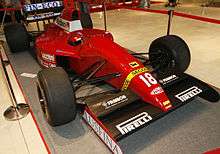
In 1988 the company became a Formula One constructor, after being hired by BMS Scuderia Italia to build their chassis. The relationship between the Italian constructor and Beppe Lucchini's racing outfit endured until 1992, with their best result being two third places: one at the 1989 Canadian Grand Prix with Andrea de Cesaris; the other at the 1991 San Marino Grand Prix, thanks to JJ Lehto. The Constructors' Championship results were: no classification in 1988, 8th in 1989 (with 8 points), 15th (with no points) in 1990, 8th in 1991 (with 5 points) and 10th in 1992 (with 2 points) by Pierluigi Martini.
Dallara returned briefly to F1 in 1999, building the test-chassis for Honda's planned and aborted return to the series.

During 2004, Dallara recruited ex-Jordan, Stewart and Jaguar F1 designer Gary Anderson, leading to speculation that the Italian company was working on another F1 project. Late in 2004 the nascent Midland team announced that Dallara would be designing and building their Formula One chassis which was due to be entered for the 2006 season. Following Midland's purchase of the Jordan team for early entry to F1 in 2005, Dallara continued co-operating with the team technically. However, the relationship fizzled out as Midland focussed its resources on developing the existing Jordan infrastructure, and a new Dallara F1 chassis never appeared.
Dallara built the cars for the Hispania Racing F1 Team's entry in the 2010 Formula One season.[2] The Hispania team's financial problems—which delayed payment of money owed to Dallara and the completion of the cars—and the alleged low quality of the F110 chassis resulted in the two parties officially ending their partnership in May 2010. The car was used in all 2010 races without any development except the graphics. They had only one aerodynamic configuration, used for all races, including Monte Carlo and Monza.[3] Geoff Willis, who joined Hispania in March 2010, criticized the F110, saying that he was disappointed at the quality and level of engineering in the car and that the design of the car was missing a lot of practices commonly employed in the process of building a Formula One car those days.[4]
On 15 April 2014 Gene Haas confirmed his new Formula One team, Haas F1 Team, had entered talks to form a partnership with Dallara in 2015 for the build of their first car.[5] On 21 February 2016, the Haas VF-16 was officially unveiled.[6]
IndyCar
First generation
Dallara was one of the original three chassis constructors when the Indy Racing League debuted its own chassis formula in the 1997 season. The first model year (1997) was named the IR7. The cars were most notably differentiated from the competing G-Force chassis by the ovoid shape of the air intake inlet, while the G-Force's was triangular. The IR8 (1998) and IR9 (1999) were essentially 1997 model year chassis with update kits.
Jim Guthrie won Dallara's first Indy car race at Phoenix on March 23, 1997.[7]
Second generation
A new model chassis was introduced for the 2000 season. When updated for 2001 the chassis was referred to as the IR-01 and for 2002 it was referred to as the IR-02.
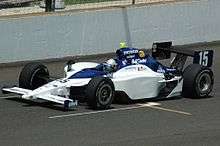
Third generation (IR-03)
For the 2003 season, Dallara rolled out the new IR-03 chassis. This chassis would become the de facto "spec car" in the series. An aerodynamic update kit was released for 2007, which changed its designation to IR-05. In addition, paddle shifters began seeing use in 2007, further developing and evolving this generation of Dallaras. Chassis bearing both the IR-03 and the IR-05 designations saw use through the 2011 season.
For the 2006 season, over 80% of the field began the season with a Dallara, a possible symptom of Panoz (manufacturer of the G-Force chassis)'s perceived lack of interest. This was around the time Panoz began delivering the DP01 chassis to the rival Champ Car series. From 2007 to 2011 all IndyCar teams used the Dallara IR-05 chassis, although a few teams entered a Panoz/G-Force chassis into the 2007 Indianapolis 500 singly. Some smaller teams continued to utilize the slightly older IR-03 designated chassis, particularly at Indianapolis, with update kits affixed to make it on equally competitive ground with the newer-assembled IR-05. Due to IndyCar IR-05 chassis and Honda Indy V8 engine development freeze for economic reasons from the start of the 2008 season, Dallara did not build new IndyCar chassis until the 2011 season.
Fourth generation (DW12)
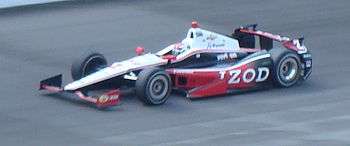
Starting in 2012, Dallara began providing the common monocoque and suspension parts for the new IndyCar formulae – known as the IndyCar Safety Cell – with the intent that the bodywork and aero parts can and will be provided by other manufacturers. The cars will be branded by the make who provides the "Aero Kit." Dallara rolled out the chassis with its own optional spec aero kit. The aero kit concept was temporarily shelved due to cost concerns, making the Dallara kit the spec for at least 2012-2014. Unique aero kits are expected to be introduced for 2015, while Dallara is expected to cease production of their own.
On 18 October, Italian manufacturer Dallara confirmed that the 2012 series car would be named after the late IndyCar driver Dan Wheldon (DW12) in honour of his work testing the car before his death two days prior at Las Vegas, with the new bumper/nerf bar section being featured, it was designed to prevent many similar single-seater crashes such as the one that killed Wheldon.[8] The nomenclature is similar to that of the old Formula One team Ligier, whose cars were labeled JSxx in memory of French F1 driver Jo Schlesser after his death at the 1968 French Grand Prix.
Dallara cars have won fifteen of the nineteen Indianapolis 500s they have contested. In 2013, Dallara reached its milestone 200th Indy car victory at Barber.[7]
Other formulae
In 2002 Dallara became the exclusive supplier for World Series by Nissan, a move that allowed them to gain the contract for the World Series by Renault in 2004. Dallara was also appointed by the FIA to be the sole supplier of the GP2 Series and the new GP3 Series, giving them a near-monopoly of every motorsport series used as a direct entry point into F1.
In 2007 Dallara created a new car model, known as "formulino", in order to fill the gap between karts and Formula Three. The first series to use the new concept was the ADAC Formel Masters in 2008.
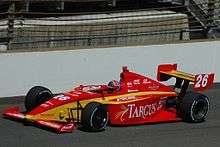
Dallara has provided the spec chassis to the Indy Lights series, formerly the Infiniti/Indy Pro Series since 2002. The car was replaced by the new generation Dallara IL-15, powered by a 2.0L turbocharged MZR-R four cylinder engine, for the 2015 Indy Lights season.[9]
Sports car racing
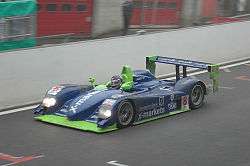
In the early 1980s, Dallara was responsible for the construction of the Lancia LC1 Group 6 prototype as well as the later LC2 Group C car, along with Lancia's partner Abarth. It would not be until 1993 that Dallara returned to endurance racing, although very few chassis would take their name. The first project was the Ferrari 333 SP, made for the new WSC regulations in the IMSA GT Championship. The 333 SP, manufactured at Michelotto, won a great number of races both in North America and Europe. Ferrari also hired Dallara to develop the racing version of the Ferrari F50, financed by French racing driver Fabien Giroix, but the project was aborted before it got off the ground, in 1998.
As a consequence, the company secured other contracts and built chassis for Toyota (GT-One), Audi (various incarnations of the R8) and Chrysler (the Oreca-run Chrysler LMP). Later, the Chrysler LMP would become Dallara's customer car available to privateers, known as the Dallara SP1, which has also served as a test mule for Nissan's aborted return to the 24 Hours of Le Mans. All these cars were competitive in prototype sports car racing, with the Audi R8 in particular becoming the most dominant chassis in modern times at the 24 Hours and the American Le Mans Series. In 2002, they built the GC21 for use in the Fuji Grand Champion Series; the car was based on the company's F3 cars.
In March 2008 the first Dallara Daytona Prototype appeared, built in collaboration with Doran for Wayne Taylor's SunTrust Racing team.
In 2015 Dallara was named as one of four constructors for the new LMP2 and DPi class regulations to debut in 2017.
Other notable cars
In 2007, Dallara and KTM produced the KTM X-Bow, a sports car with two seats, which was presented in its final version at the Bologna Motor Show.
Dallara also provided engineering services for Renault (R.S. 01), Alfa Romeo (8C and 4C), Audi (DTM and LeMans series), Bugatti (Veyron), Ferrari, Porsche, and Maserati (MC12).
Aerospace
For the Rosetta probe Dallara designed the drill that is part of the Philae robotic lander. Dallara has also partnered with Raytheon to provide the MALD for the United States Air Force.
Simulator
The simulator provides engineers, teams and drivers the opportunity to test and develop the whole car setup and data analysis systems, to optimize the driving skills and to learn new tracks. Allows a driver to drive exactly the same monocoque used on the track, with the same controls (pedals, brake, instrument panel) and the same level of feedback (effort steering and brake). The helmet is mandatory, as well as the gloves, the shoes and the race suit.
The advanced system of complete circuit simulation, obtained by laser scanning high-fidelity combined with sophisticated multi-body model, allows to replicate the real car behavior with unprecedented accuracy. The pilot has the opportunity to learn not only the speed with which it must take a curve, but the same curve as it really is; roughness of the terrain, bumps and curbs are entirely modeled thanks to the technology of laser scanning data processing.
There are all the cars and the tracks of all the categories in which it operates Dallara, from Formula Three to IndyCar, from Monte Carlo to Indianapolis.[1]
It is possible to change any configuration parameter in the car to meet the needs of the pilot and test the changes in a controlled environment. The thermal model of the tire allows the preparation of structures for both the qualification for the race, considering the wear of the tires, the characteristics of the track and weather conditions. All changes can be imposed immediately via the user interface developed in Dallara. This has been specifically designed to ensure ease of use, data security and speed of execution.[1]
The simulator allows you to analyze the same data channels of a real car, with even greater precision in the absence of noise in the signal and error during calibration tool. The fidelity of the mathematical model has been validated carefully by professional pilots in various categories. It is also possible to access a series of channels normally impossible to obtain on a real machine (for example, the forces on the tires). This allows a more detailed and scrupulous behavior of the vehicle.[1]
Complete Formula One World Championship results
(key) (results in bold indicate pole position)
| Year | Team | Chassis | Engine | Tyres | Drivers | 1 | 2 | 3 | 4 | 5 | 6 | 7 | 8 | 9 | 10 | 11 | 12 | 13 | 14 | 15 | 16 | 17 | 18 | 19 | Points | WCC |
|---|---|---|---|---|---|---|---|---|---|---|---|---|---|---|---|---|---|---|---|---|---|---|---|---|---|---|
| 1988 | BMS Scuderia Italia | 3087 188 |
Ford DFR 3.5 V8 | G | BRA | SMR | MON | MEX | CAN | DET | FRA | GBR | GER | HUN | BEL | ITA | POR | ESP | JPN | AUS | 0 | NC | ||||
| DNPQ | Ret | Ret | Ret | DNPQ | 8 | 12 | 11 | 15 | Ret | 8 | Ret | 7 | 10 | Ret | Ret | |||||||||||
| 1989 | BMS Scuderia Italia | 189 | Ford DFR 3.5 V8 | P | BRA | SMR | MON | MEX | USA | CAN | FRA | GBR | GER | HUN | BEL | ITA | POR | ESP | JPN | AUS | 8 | 8th | ||||
| DNPQ | 7 | 4 | 13 | Ret | 6 | Ret | DNPQ | Ret | 7 | Ret | 11 | Ret | Ret | 9 | Ret | |||||||||||
| 13 | 10 | 13 | Ret | 8 | 3 | DNQ | Ret | 7 | Ret | 11 | Ret | Ret | 7 | 10 | Ret | |||||||||||
| 1990 | BMS Scuderia Italia | 190 | Ford DFR 3.5 V8 | P | USA | BRA | SMR | MON | CAN | MEX | FRA | GBR | GER | HUN | BEL | ITA | POR | ESP | JPN | AUS | 0 | NC | ||||
| Ret | Ret | Ret | Ret | Ret | 11 | Ret | 10 | Ret | Ret | 15 | Ret | Ret | Ret | |||||||||||||
| Ret | Ret | Ret | Ret | Ret | 13 | DSQ | Ret | DNQ | Ret | Ret | 10 | Ret | Ret | Ret | Ret | |||||||||||
| DNQ | 14 | |||||||||||||||||||||||||
| 1991 | BMS Scuderia Italia | 191 | Judd GV 3.5 V10 | P | USA | BRA | SMR | MON | CAN | MEX | FRA | GBR | GER | HUN | BEL | ITA | POR | ESP | JPN | AUS | 5 | 8th | ||||
| Ret | 11 | DNPQ | 6 | 9 | DNPQ | DNPQ | 10 | 10 | Ret | 8 | 10 | Ret | 15 | Ret | 7 | |||||||||||
| Ret | Ret | 3 | 11 | Ret | Ret | Ret | 13 | Ret | Ret | Ret | Ret | Ret | 8 | Ret | 12 | |||||||||||
| 1992 | BMS Scuderia Italia | 192 | Ferrari 037 3.5 V12 |
G | RSA | MEX | BRA | ESP | SMR | MON | CAN | FRA | GBR | GER | HUN | BEL | ITA | POR | JPN | AUS | 2 | 10th | ||||
| Ret | 8 | 8 | Ret | 11 | 9 | 9 | 9 | 13 | 10 | DNQ | 7 | 11 | Ret | 9 | Ret | |||||||||||
| Ret | Ret | Ret | 6 | 6 | Ret | 8 | 10 | 15 | 11 | Ret | Ret | 8 | Ret | 10 | Ret | |||||||||||
| 2010 | Hispania Racing F1 Team | F110 | Cosworth CA2010 V8 |
B | BHR |
AUS |
MAL |
CHN |
ESP |
MON |
TUR |
CAN |
EUR |
GBR |
GER |
HUN |
BEL |
ITA |
SIN |
JPN |
KOR |
BRA |
ABU |
0 | 11th | |
| Ret | 14 | 15 | 17 | Ret | 14 | 20 | 18 | 18 | 19 | |||||||||||||||||
| Ret | Ret | 16 | 16 | Ret | Ret | Ret | Ret | 20 | 19 | 17 | Ret | Ret | Ret | 15 | 14 | 21 | 19 | |||||||||
| 20 | Ret | 19 | 20 | 19 | 16 | 15 | ||||||||||||||||||||
| Ret | 22 | 20 |
See also
References
- 1 2 3 4 "Official Site Dallara Automobili". Retrieved 2013-07-19.
- ↑ "2010 FIA Formula One World Championship Entry List" (Press release). FIA. 2009-11-30. Retrieved 2009-11-30.
- ↑ Beer, Matt (2010-05-26). "Hispania and Dallara end partnership". autosport.com. Haymarket Publications. Retrieved 2010-05-26.
- ↑ Rencken, Dieter; Elizalde, Pablo (2010-04-02). "Willis unimpressed by HRT's car design". autosport.com. Haymarket Publications. Retrieved 2010-04-07.
- ↑ "Haas confirms Dallara talks". planetf1.com. PlanetF1. 2014-04-15. Retrieved 2014-04-15.
- ↑ Perkins, Chris (21 February 2016). "Haas F1 Reveals First U.S. F1 Car in 30 Years, The VF16". Road & Track. Retrieved 25 March 2016.
- 1 2 Lewandowski, Dave (2013-04-01). "Dallara to mark its 200th win in series at Barber". IndyCar. Retrieved 2013-04-05.
- ↑ "Dallara to name 2012 IndyCar in honour of Dan Wheldon". Autosport.com. 18 October 2011. Retrieved 18 October 2011.
- ↑ DiZinno, Tony (31 October 2013). "No surprise: Indy Lights confirms Dallara for new 2015 chassis". NBC Sports. NBC Universal. Retrieved 14 December 2015.
External links
| Wikimedia Commons has media related to Dallara racing cars. |
- Official Dallara website (English)
- Dallara's Profile on Historic Racing
- History of Dallara in Formula 3